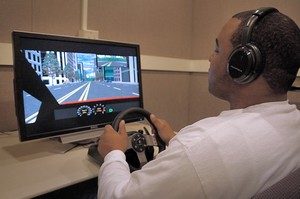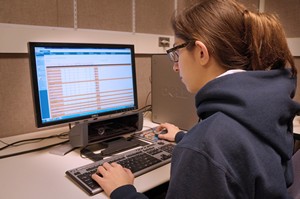Location: G752 IOE
Faculty in charge: Nadine Sarter, Ph.D.
Official Website
The THinC Lab’s interests include design and evaluation of multimodal interfaces (including sight, sound, and touch) in support of human-computer interaction and computer-supported collaborative work, support for attention and interruption management through adaptive notifications and preattentive reference, design of decision aids that support trust calibration and adaptive function allocation, and human error and error/disturbance management. The lab’s research is conducted primarily in the context of highly complex event-driven domains, such as aviation, the military, space operations, medicine, and the automotive industry
 Driving simulator: The driving simulator is currently being used to compare the ability of younger and older adults to process two or more concurrent visual, auditory, and/or tactile stimuli while performing driving-related tasks.Findings from this research will help develop design guidance and recommendations for future multimodal in-vehicle technologies, which will, in turn, contribute to increased public safety.
Driving simulator: The driving simulator is currently being used to compare the ability of younger and older adults to process two or more concurrent visual, auditory, and/or tactile stimuli while performing driving-related tasks.Findings from this research will help develop design guidance and recommendations for future multimodal in-vehicle technologies, which will, in turn, contribute to increased public safety.
 ATC simulator: Research conducted in the THinC Lab includes studies on attention management – how to design interfaces that best support operators’ attention allocation depending on the system, the environment, and the tasks at hand. The Air Traffic Control (ATC) simulator is currently being used to investigate attentional narrowing, a potentially dangerous attentional state in which attention is narrowed to only one or a few tasks or display elements.
ATC simulator: Research conducted in the THinC Lab includes studies on attention management – how to design interfaces that best support operators’ attention allocation depending on the system, the environment, and the tasks at hand. The Air Traffic Control (ATC) simulator is currently being used to investigate attentional narrowing, a potentially dangerous attentional state in which attention is narrowed to only one or a few tasks or display elements.
 Electronic medical record (EMR) simulator: Display clutter is a major problem in EMRs (digital medical charts), and it can lead to delayed diagnoses and medical errors. This simulated EMR is being used to determine the effects of clutter on physicians’ ability to accurately retrieve critical patient information. Eye tracking measures are also collected using a desktop-mounted eye tracker (pictured) and used to trace the effects of clutter. Ultimately, our goal is to develop an eye tracking-based adaptive EMR where the presentation of information is adjusted in real time to prevent clutter.
Electronic medical record (EMR) simulator: Display clutter is a major problem in EMRs (digital medical charts), and it can lead to delayed diagnoses and medical errors. This simulated EMR is being used to determine the effects of clutter on physicians’ ability to accurately retrieve critical patient information. Eye tracking measures are also collected using a desktop-mounted eye tracker (pictured) and used to trace the effects of clutter. Ultimately, our goal is to develop an eye tracking-based adaptive EMR where the presentation of information is adjusted in real time to prevent clutter.
